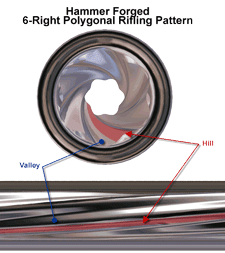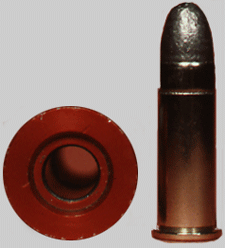Home | Glossary | Resources | Help | Contact Us | Course Map
Archival Notice
This is an archive page that is no longer being updated. It may contain outdated information and links may no longer function as originally intended.
Damaged Bullets
In some cases, bullets bear no microscopic marks of value for comparison purposes because they are fragmented, distorted, deformed, or otherwise damaged.
There may be retrievable information if all of the following are present:
- One or more measurable land impression
- One or more measurable groove impression
- Sufficient bullet remains to determine a measured caliber
Used with caution in selected cases, this information may allow a calculation of the number of land and groove impressions present prior to the damage.
If information exists to perform the calculation and if direction of twist can be determined, then sufficient information is available to search the GRC file for possible firearms that could have fired the bullet.
| The formula for the calculation is as follows: |
Number of lands and grooves = 
Applied to 9mm Luger bullet where:
Number of lands and grooves = = 6.06, or 6 |
Microscopic Marks
The greatest potential for obtaining forensic information from fired bullets is found within the land and groove impressions in the form of microscopic striations.
The information obtained from these striations goes beyond class characteristics (GRC) and is
- unique to a particular firearm,
- reproducible shot after shot,
- identifiable with a specific firearm.
If microscopic marks are present, they must be evaluated for their potential; this information should be noted in the worksheet and related report.
There are three possibilities resulting from the evaluation of microscopic marks on fired bullets:
- Microscopic marks are present and sufficient for comparison purposes.
- Microscopic marks are present, but insufficient for comparison purposes.
- Microscopic marks are not present, precluding an identification.
Rifling Impressions
Polygonal rifling prohibits the examiner from measuring the width of land and groove impressions because the lands and grooves have a rounded profile instead of a well-defined rectangular profile.
Polygonal rifling is most frequently observed in firearms marketed by Glock and Heckler & Koch. In the FBI GRC file, the land and groove widths for these firearms are listed as 0.000.
Firing a cartridge in an inappropriate firearm with a barrel of a larger diameter than the bullet may leave no rifling impressions on the bearing surface of a bullet.
An adapter (subcaliber device) is an auxiliary chamber inserted into the chamber of a firearm, allowing the firing of smaller diameter or lower power ammunition. Adapters may or may not be rifled. If rifled, the impressions would originate from the adapter, not the firearm. Several adapters are listed in the GRC file.
Additional Online Courses
- What Every First Responding Officer Should Know About DNA Evidence
- Collecting DNA Evidence at Property Crime Scenes
- DNA – A Prosecutor’s Practice Notebook
- Crime Scene and DNA Basics
- Laboratory Safety Programs
- DNA Amplification
- Population Genetics and Statistics
- Non-STR DNA Markers: SNPs, Y-STRs, LCN and mtDNA
- Firearms Examiner Training
- Forensic DNA Education for Law Enforcement Decisionmakers
- What Every Investigator and Evidence Technician Should Know About DNA Evidence
- Principles of Forensic DNA for Officers of the Court
- Law 101: Legal Guide for the Forensic Expert
- Laboratory Orientation and Testing of Body Fluids and Tissues
- DNA Extraction and Quantitation
- STR Data Analysis and Interpretation
- Communication Skills, Report Writing, and Courtroom Testimony
- Español for Law Enforcement
- Amplified DNA Product Separation for Forensic Analysts





